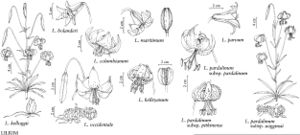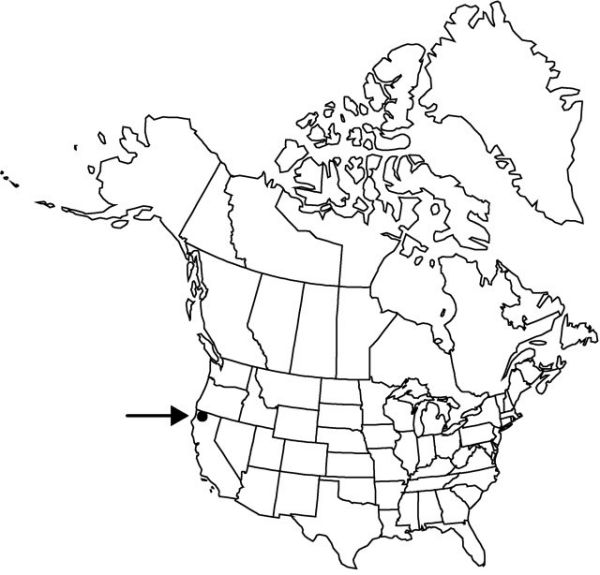Difference between revisions of "Lilium pardalinum subsp. wigginsii"
Novon 12: 258. 2002.
FNA>Volume Importer |
imported>Volume Importer |
||
| (5 intermediate revisions by 2 users not shown) | |||
| Line 8: | Line 8: | ||
}} | }} | ||
|common_names=Wiggins’ lily | |common_names=Wiggins’ lily | ||
| − | |basionyms={{Treatment/ID/ | + | |special_status={{Treatment/ID/Special_status |
| + | |code=F | ||
| + | |label=Illustrated | ||
| + | }}{{Treatment/ID/Special_status | ||
| + | |code=E | ||
| + | |label=Endemic | ||
| + | }} | ||
| + | |basionyms={{Treatment/ID/Basionym | ||
|name=Lilium wigginsii | |name=Lilium wigginsii | ||
|authority=Beane & Vollmer | |authority=Beane & Vollmer | ||
| + | |rank=species | ||
| + | |publication_title=Contr. Dudley Herb. | ||
| + | |publication_place=4: 355, plate 18. 1955 | ||
}} | }} | ||
|synonyms= | |synonyms= | ||
| Line 36: | Line 46: | ||
-->{{#Taxon: | -->{{#Taxon: | ||
name=Lilium pardalinum subsp. wigginsii | name=Lilium pardalinum subsp. wigginsii | ||
| − | |||
|authority=(Beane & Vollmer) M. W. Skinner | |authority=(Beane & Vollmer) M. W. Skinner | ||
|rank=subspecies | |rank=subspecies | ||
| Line 50: | Line 59: | ||
|publication title=Novon | |publication title=Novon | ||
|publication year=2002 | |publication year=2002 | ||
| − | |special status= | + | |special status=Illustrated;Endemic |
| − | |source xml=https:// | + | |source xml=https://bitbucket.org/aafc-mbb/fna-data-curation/src/2e0870ddd59836b60bcf96646a41e87ea5a5943a/coarse_grained_fna_xml/V26/V26_324.xml |
|genus=Lilium | |genus=Lilium | ||
|species=Lilium pardalinum | |species=Lilium pardalinum | ||
Latest revision as of 22:14, 5 November 2020
Bulbs branching occasionally, often irregularly, 1.6–3 × 3.9–11.8 cm, 0.2–0.5 times taller than long; scales 2–4-segmented, longest 1–2 cm. Stems to 1.7 m, weakly clonal and not forming large colonies. Leaves ± evenly distributed along middle of stem, occasionally scattered, especially in young plants, or in 1–6 whorls or partial whorls, 3–19 leaves per whorl, usually horizontal and drooping at the tips, sometimes ascending, 6–24.6 × 0.5–3.5 cm, 4–22 times longer than wide; blade elliptic to narrowly linear, usually lanceolate in distal leaves, margins not undulate. Racemes 1–15-flowered. Flowers not fragrant; sepals and petals reflexed 1/3 along length from base, usually uniformly orange or yellow-orange, rarely light orange or light red-orange on distal 1/3–2/5 and lighter proximally; sepals appearing wide for their length, 3.5–7.1 × 1–2 cm; petals 3.4–7.1 × 0.9–2 cm; stamens moderately exserted, often malformed and/or shrunken; filaments moderately spreading, diverging 10°–18° from axis; anthers pale yellow, 0.5–1.3 cm, pollen yellow or orange; pistil 3.1–4.3 cm; ovary 1–2.2 cm; pedicel 6–29.5 cm. Capsules 2.3–4.2 × 1.2–2.1 cm, 1.6–2.6 times longer than wide. Seeds 123–198. 2n = 24.
Phenology: Flowering summer (Jul–Aug).
Habitat: Wet thickets and meadows among conifers
Elevation: 800–2000 m
Discussion
Subspecies wigginsii is a Klamath Mountain endemic that occurs widely along the county boundary between Del Norte and Siskiyou counties, California, and east through southeastern Josephine County, Oregon, to Mount Ashland in Jackson County (O. H. Ballantyne 1983). It intergrades with subsp. shastense in the Marble Mountains of Siskiyou County. The solid orange flowers and yellow anthers are distinctive. Genetic instability in this subspecies is frequently expressed as malformed flowers with shrunken or missing reproductive structures.
Selected References
None.

